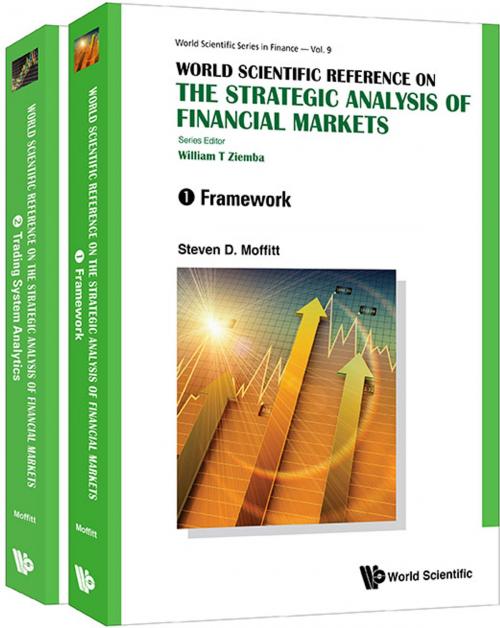The Strategic Analysis of Financial Markets
(In 2 Volumes)Volume 1: FrameworkVolume 2: Trading System Analytics
Business & Finance, Finance & Investing, Finance, Investments & Securities| Author: | Steven D Moffitt | ISBN: | 9789813143777 |
| Publisher: | World Scientific Publishing Company | Publication: | March 24, 2017 |
| Imprint: | WSPC | Language: | English |
| Author: | Steven D Moffitt |
| ISBN: | 9789813143777 |
| Publisher: | World Scientific Publishing Company |
| Publication: | March 24, 2017 |
| Imprint: | WSPC |
| Language: | English |
Volume 1 of "The Strategic Analysis of Financial Markets," — Framework, is premised on the belief that markets can be understood only by dropping the assumptions of rationality and efficient markets in their extreme forms, and showing that markets still have an inherent order and inherent logic. But that order results primarily from the "predictable irrationality" of investors, as well as from people's uncoordinated attempts to profit. The market patterns that result do not rely on rationality or efficiency.
A framework is developed for understanding financial markets using a combination of psychology, statistics, game and gambling analysis, market history and the author's experience. It expresses analytically how professional investors and traders think about markets — as games in which other participants employ inferior, partially predictable strategies. Those strategies' interactions can be toxic and lead to booms, bubbles, busts and crashes, or can be less dramatic, leading to various patterns that are mistakenly called "market inefficiencies" and "stylized facts."
A logical case is constructed, starting from two foundations, the psychology of human decision making and the "Fundamental Laws of Gambling." Applying the Fundamental Laws to trading leads to the idea of "gambling rationality" (grationality), replacing the efficient market's concept of "rationality." By classifying things that are likely to have semi-predictable price impacts (price "distorters"), one can identify, explore through data analysis, and create winning trading ideas and systems. A structured way of doing all this is proposed: the six-step "Strategic Analysis of Market Method." Examples are given in this and Volume 2.
Volume 2 of "The Strategic Analysis of Financial Markets" — Trading System Analytics, continues the development of Volume 1 by introducing tools and techniques for developing trading systems and by illustrating them using real markets. The difference between these two Volumes and the rest of the literature is its rigor. It describes trading as a form of gambling that when properly executed, is quite logical, and is well known to professional gamblers and analytical traders.
But even those elites might be surprised at the extent to which quantitative methods have been justified and applied, including a life cycle theory of trading systems. Apart from a few sections that develop background material, Volume 2 creates from scratch a trading system for Eurodollar futures using principles of the Strategic Analysis of Markets Method (SAMM), a principled, step-by-step approach to developing profitable trading systems. It has an entire Chapter on mechanical methods for testing and improvement of trading systems, which transcends the rather unstructured and unsatisfactory "backtesting" literature. It presents a breakout trend following system developed using factor models. It also presents a specific pairs trading system, and discusses its life cycle from an early, highly profitable period to its eventual demise. Recent developments in momentum trading and suggestions on improvements are also discussed.
Volume 1 of "The Strategic Analysis of Financial Markets," — Framework, is premised on the belief that markets can be understood only by dropping the assumptions of rationality and efficient markets in their extreme forms, and showing that markets still have an inherent order and inherent logic. But that order results primarily from the "predictable irrationality" of investors, as well as from people's uncoordinated attempts to profit. The market patterns that result do not rely on rationality or efficiency.
A framework is developed for understanding financial markets using a combination of psychology, statistics, game and gambling analysis, market history and the author's experience. It expresses analytically how professional investors and traders think about markets — as games in which other participants employ inferior, partially predictable strategies. Those strategies' interactions can be toxic and lead to booms, bubbles, busts and crashes, or can be less dramatic, leading to various patterns that are mistakenly called "market inefficiencies" and "stylized facts."
A logical case is constructed, starting from two foundations, the psychology of human decision making and the "Fundamental Laws of Gambling." Applying the Fundamental Laws to trading leads to the idea of "gambling rationality" (grationality), replacing the efficient market's concept of "rationality." By classifying things that are likely to have semi-predictable price impacts (price "distorters"), one can identify, explore through data analysis, and create winning trading ideas and systems. A structured way of doing all this is proposed: the six-step "Strategic Analysis of Market Method." Examples are given in this and Volume 2.
Volume 2 of "The Strategic Analysis of Financial Markets" — Trading System Analytics, continues the development of Volume 1 by introducing tools and techniques for developing trading systems and by illustrating them using real markets. The difference between these two Volumes and the rest of the literature is its rigor. It describes trading as a form of gambling that when properly executed, is quite logical, and is well known to professional gamblers and analytical traders.
But even those elites might be surprised at the extent to which quantitative methods have been justified and applied, including a life cycle theory of trading systems. Apart from a few sections that develop background material, Volume 2 creates from scratch a trading system for Eurodollar futures using principles of the Strategic Analysis of Markets Method (SAMM), a principled, step-by-step approach to developing profitable trading systems. It has an entire Chapter on mechanical methods for testing and improvement of trading systems, which transcends the rather unstructured and unsatisfactory "backtesting" literature. It presents a breakout trend following system developed using factor models. It also presents a specific pairs trading system, and discusses its life cycle from an early, highly profitable period to its eventual demise. Recent developments in momentum trading and suggestions on improvements are also discussed.















